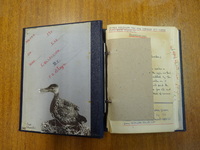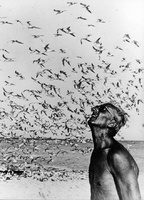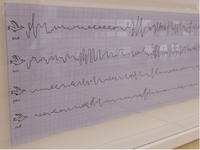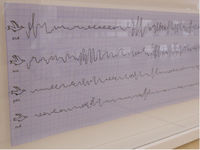Items
Site
The Medicine Chest
keywords is exactly
sadness
-

Diary of an oologist
"In 2019, Honours in Curatorship student Nathalie Viruly, who completed her Bachelor of Social Science in Politics and Sociology, was similarly struck by the silence and loss evoked by the [Peter Steyn] collection. Viruly honed in on the moments documented in the notebooks, which capture the loss of life in the reproductive life of these birds and reveal ‘stories of avian tragedy’: Young taken by predator; 1 young accidentally killed; 2 eggs failed to hatch; 2 infertile; Chick disappeared without a trace; Eggs disappeared; Literally cooked by the [corrugated] roof; Nest empty – egg collectors? (Viruly 2018: online). Her focus on these moments in the scientific journal poignantly reveals the conflation between science and emotion and invites the viewer to re-examine hierarchies of loss" (Liebenberg 2021: 219). -

Tabloid medicine chest from Scott Polar Expedition
The expedition carried with them a Tabloid Medicine Chest. On the 11th of March, knowing that the party was unlikely to survive, Scott ordered Edward Wilson, the expedition’s Chief Scientist and a qualified doctor, to divide the painkillers between them so they could each end their life on their own terms. Writing in his diary on that day, Scott states, “I practically ordered Wilson to hand over the means of ending our troubles to us, so that anyone of us may know how to do so". Scott, Bowers and Oates had thirty opium tabloids apiece and Wilson, the morphine. Scotts diary entry on either the 22nd or 23rd of March showed that they had a change of heart however: “no fuel and only one or two left of food — must be near the end. Have decided that it shall be natural — we shall march for the depot with or without our effects and die in our tracks". -

Second star to the right and straight on 'til morning
Cyanotype on paper. Ink on perspex. The work shows the exact positioning of the stars from J.M. Barrie’s window at 3 Adelphi Terrace, London (51°30'N 0°7'21"W), on Saturday, 19 June 1937 – the night of his death. Based on the direction of his window, I was able to locate the ‘second star to the right’ at the 45 degree angle he would have stood and viewed the night sky. Hopefully, he reached his destination, after departing the flat and traveling ‘straight on till morning’. -

The hut
Captain Scott writes in his den in the Terra Nova hut in this October 7, 1911. -

“I am just going outside and may be some time"
After initially making good progress, Terra Nova expedition party’s prospects steadily worsened as they struggled northward. Deteriorating weather, frostbite, snow blindness, hunger and exhaustion led to Edgar Evans dying on 17 February and Lawrence Oates, whose condition was aggravated by an old war-wound to the extent that he was barely able to walk, voluntarily leaving his tent on 16 March and walking to his death. (“I am just going outside and may be some time".)" (Liebenberg 2011: 75). -

Simone
A year after Simone's death from cancer, Cousteau announced that he had been having an affair with a woman, Francine Triplet, for over a decade. He also had two children with her, Diane and Pierre-Yves. -

Untitled
An IV drip releases a drop on a handkerchief floating above a fan, drying it before next one falls. -

Pier 59
A monumental installation piece recreating the ocean liner Titanic as a floating deck plan (in its original size – 882 feet long; 92 feet wide), projected in light onto the surface of the Hudson River at Pier 59 (due west of West 18th Street), the ship's intended destination in 1912. -

A letter to Barrie
My dear Barrie, We are pegging out in a very comfortless spot. Hoping this letter may be found and sent to you, I write a word of farewell.... More practically I want you to help my widow and my boy – your godson. (...) I am not at all afraid of the end, but sad to miss many a humble pleasure which I had planned for the future on our long marches. I may not have proved a great explorer, but we have done the greatest march ever made and come very near to great success. Goodbye, my dear friend. Yours ever, R. Scott. (Excerpt from letter penned by Scott to Barrie on 29 March 1912) -

Left luggage
St. Pancras Station, London. Suitcases full of holes, handkerchiefs and string sculpture - destroyed by the train pulling out of the station -

Vatnajökull (the sound of)
A live phone line was created to an Icelandic glacier, via an underwater microphone submerged in Jökulsárlón lagoon, an outlet of Vatnajökull. The number 07757001122 could be called from any telephone in the world, and the listener would hear the sound of the glacier melting. -

Flood
Photo of water in Jagger Library by photographer, Lerato Maduna. On 18 April, the Jagger Library — the medicine chest's home — caught fire. The fire started on the lower sections of Rhodes Memorial at the foot of Table Mountain, and set alight landscape, monuments, and many of the university’s buildings. The library only caught fire in the late afternoon, but became a raging inferno as books, artworks, manuscripts that were worked on frequently, institutional, and administrative records of Special Collections, as well as the entire African Film collection, all went up in flames. -

Burrowing
Extract from 'A Child in Time': "Later, in the sorry months and years, Stephen was to make efforts to re-enter this moment, to burrow his way back through the folds between the events, crawl between the covers, and reverse his decision. But time – not necessarily as it is, for who knows that, but as thought constituted it – monomanically forbids second chances" (McEwan 1987: 14). -

"I have scars on my hands from touching certain people"
"The words of Seymour Glass, eldest sibling of the Glass family – a lesser known creation of J.D. Salinger’s literary world. The story of this family of child geniuses, who appeared on a 1927 radio quiz show called 'It’s a Wise Child', is chronicled in three of his books – mostly centering on the relationship between the two eldest brothers, Buddy and Seymour. Salinger favours Seymour. He was the most brilliant and idiosyncratic of all the children and unfortunately, for the most part, only present as a memory – since he committed suicide, age 31. Buddy reminisces about one specific Seymour moment: His mother urging him to see a psychiatrist and him telling her that he doesn’t need a head doctor – he needs a hand doctor or a dermatologist, whereupon he looks at his hands and tells her he has these scars – these discolourations on them – from touching certain people. Certain heads, certain colours and textures of human hair leave permanent marks on him. When he put his hand on his little sister Franny’s head when she was still in the carriage, it left a mark. Or with her twin brother, Zooey, when he was six or seven, during a spooky movie. He put his hand on Zooey’s head when he went under the seat to avoid watching a scary scene. It left a mark. Other things, too. Charlotte, the girl he was in love with, tried to run away from him once and he grabbed her dress. It left a permanent lemon-yellow mark on the palm of his right-hand (Salinger 1964:59). His hands were filled with these discolourations – these physical manifestations of his emotions. They became a type of medical condition. And he needed to cure it" (Liebenberg 2011: 91 - 93). Salinger recounts the day of Seymour's suicide in a short story he later wrote, called 'A Perfect Day for Bananafish'. -

Neck-support
"Made from oak, the object was used to support the neck of an individual during post-mortem examinations conducted at the University of Cape Town’s mortuary unit. My first encounter with it was in Dr Yeats’s office in the Pathology Learning Centre, many years ago. Heavy in weight and invested with the traces of hundreds of individuals, it somehow seemed more representative of disease, than the 3500 specimens floating in formaldehyde displayed in the surrounding rooms " ( Liebenberg 2021: 257). -

The Sea Birds of Isabella
Aired between 1968 and 1976, 'The Undersea World of Jacques Cousteau' was a documentary television series about underwater marine life. It was directed by Alan Landsburg and hosted by French filmmaker, researcher, and marine explorer Jacques Cousteau. In the 33rd episode of the series, titled 'The Sea Birds of Isabella', the crew journeys off the coast of Mexico to an island to study its tropical birds. Three years after it was shown, Cousteau's son, Phillipe (then aged 38) died trying to land his seaplane, called the Flying Calypso, on the Taos River in Portugal. -

Flight
A chorus of juvenile heartbeats affected by Atrial Septal (ASD) and Ventricular Septal Defects (VSD), Patent Ductus Arteriosus(PDA), and Aortic Valve Stenosis (AVS), transposed to a higher frequency to simulate birdsong -

The Lost Boys
After they left Neverland, Mr and Mrs Darling adopted the Lost Boys. Before they had attended school a week they saw what goats they had been not to remain on the island; but it was too late, and they settled down to being as ordinary as “you or me or Jenkins minor” (Barrie 1989: 180). It is sad to say that the power to fly gradually left them. “At first Nana tied their feet to the bedposts so that they should not fly away in the night; and one of their diversions by day was to pretend to fall off buses; but by and by they ceased to tug at their bonds in bed, and they found that they hurt themselves when they let go of the bus. In time they could not even fly after their hats. Want of practice, they called it; but what it really meant was they no longer believed” ( Barrie 1989: 180-181). -

The Swamp of Sadness
-

Big Good Strong Hands...
The 1984 film, 'The Neverending Story', features Pyornkrachzark, the Rockbiter, a large creature made of stone. The Rockbiter species are named due to their diet of rocks and earth-based materials. The Rockbiter seen in the film particularly has a liking for limestone. In the novel and the first film, the Rockbiter appears early among the messengers sent to see the Childlike Empress at the Ivory Tower during the Nothing crisis. In the first film he ultimately reappears, encountered by Atreyu. He has lost faith in himself after failing to save his travelling companions from the Nothing, and advises Atreyu to flee.


